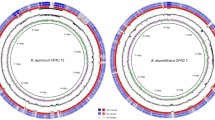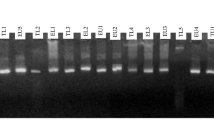Abstract.
The polymerase chain reaction with arbitrary primers (RAPD) discriminated between two separately maintained cultures of Bradyrhizobium japonicum USDA 110 differing in symbiotic performance under drought conditions. Since strain 110 is used in inoculum production, the use of RAPD to monitor inoculum cultures could help to preserve their genetic composition and prevent the loss of important symbiotic properties. The use of RAPD could also be extended to other B. japonicum strains currently used in inoculum production.
Similar content being viewed by others
Author information
Authors and Affiliations
Additional information
Received: 19 May 1997 / Accepted: 27 June 1997
Rights and permissions
About this article
Cite this article
Mathis, J., McMillin, D., Champion, R. et al. Genetic Variation in Two Cultures of Bradyrhizobium japonicum 110 Differing in Their Ability to Impart Drought Tolerance to Soybean. Curr Microbiol 35, 363–366 (1997). https://doi.org/10.1007/s002849900269
Issue Date:
DOI: https://doi.org/10.1007/s002849900269




